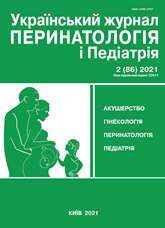Features of Pap smears in women of reproductive life with papillomavirus 16, 18
DOI:
https://doi.org/10.15574/PP.2021.86.96Keywords:
HPV16, 18, ASCUS, LSIL, HSIL, PAPAbstract
Introduction. According to modern data, cervical diseases do not occur by chance. Precancerous lesions vary from person to person and become invasive over time. The need for specific diagnostic methods for early detection of cervical cancer in women of reproductive age always remains relevant. Over the years, numerous diagnostic, cytological and histological studies have been carried out to identify malignant lesions of the cervix. Human papillomavirus (HPV) is a widespread sexually transmitted infection that affects both women and men around the world and plays an important role in the development of cervical disease. It is the most common sexually transmitted virus in the United States of America. For the first time in 1942, Papanicolaou emphasized the possibility of using smears (PAP smears) from the cervix and from the vagina to diagnose cervical disease. PAP preparations of smears are mainly multilayered flat epithelial cells of the ectocervix and vagina, endocervical cylindrical cells, including mononuclear and polynuclear inflammatory cells that enter the vagina through diapedesis from the surface of the epithelial layer, mixing with the mucoid fluid produced by the endocervical epithelial fluid.
Purpose — using objective criteria for cytological examination to identify neoplastic changes in the cervix.
Materials and methods. The study included 100 women of reproductive age (18–45 years old) during 2015–2020. Of these, 20 were in the control group (group I — control) and 80 — in the high-risk group for cervical cancer (group II — the main group). Group II women were also divided into 2 subgroups: II A — with pathology of the cervix (n=41), II B — without pathology of the cervix (n=39). The study included patients with a positive result on HPV 16/18 including patients whose PAP smears revealed intracellular damage. Pap smears were included in the study according to the following criteria. The smears contained a sufficient number of squamous epithelial cells and their integrity was preserved. Endocervical cells were monitored in all PAP smears. The examination was carried out with at least 5 cells in each, not completely, and with 2 clusters of endocervical glandular or squamous metaplastic cells. Squamous epithelial cells covered at least 10% of the preparation. Bloody, technically artifactic preparations without clinical data have not been studied. The deficit rate did not exceed 3%, and high interest rates on artifacts were not included in the study. Despite the small number of cells in the presence of abnormal cells, this was unequivocally considered sufficient.
Results. Interpretation of PAP smear results identified n=35 ASCUS patients, n=24 LSIL, n=21 HSIL patients in the PAP smear positive reproductive age group. HPV serotypes 16.18 were found in 24 of these patients. In women of the II B subgroup, no pathological changes in the cervix were observed.
Conclusions. In women of reproductive age with positive HPV 16, 18, for the diagnosis of precancerous diseases of the cervix, taking pap smears is an integral part of the study. As a result of the study, it was revealed that, despite the absence of a clinical picture, pathological changes at the cell level are detected.
References
Beckman CRB et al. (2002). APGO Objectives. Cervical neoplasia and carcinoma. In Beckman CRB et al. editors. Obstetrics and Gynecology. 4th ed. Philadelphia: Lippincott Williams and Wilkins: 547–565.
Castle PE, Stoler MH, Wright TC, Sharma A, Wright TL, Behrens CM. (2011). Performance of carcinogenic human papillomavirus (HPV) testing and HPV16 or HPV18 genotyping for cervical cancer screening of women aged 25 years and older: A sub analysis of the ATHENA study. Lancet Oncol. 12: 880–90. https://doi.org/10.1016/S1470-2045(11)70188-7
Kulkarni SS, Kulkarni SS, Vastrad PP, et al. (2011). Prevalence and distribution of high risk human papillomavirus (HPV) Types 16 and 18 in Carcinoma of cervix, saliva of patients with oral squamous cell carcinoma and in the general population in Karnataka, India. Asian Pac J Cancer Prev. 12(3): 645–648.
Meisels. A ve Fortin. R. (1976). Condylomatous lesions of the servix and vagina.I sytologic patterens. Acta Cytol. 20: 505–509.
Noorani HZ, Brown A, Skidmore B, Stuart GCE. 2003. Liquid-based cytology and human papillomavirus testing in cervical cancer screening. Ottawa, Ontario, Canada: CCOHTA (Canadian Coordinating Office for Health Technology Assessment).
Zhao FH, Lewkowitz AK, Hu SY, et al. (2012). Prevalence of human papillomavirus and cervical intraepithelial neoplasia in China: a pooled analysis of 17 population-based studies. Int J Cancer. 131: 2929–38. https://doi.org/10.1002/ijc.27571; PMid:22488743 PMCid:PMC3435460
Downloads
Published
Issue
Section
License
The policy of the Journal “Ukrainian Journal of Perinatology and Pediatrics” is compatible with the vast majority of funders' of open access and self-archiving policies. The journal provides immediate open access route being convinced that everyone – not only scientists - can benefit from research results, and publishes articles exclusively under open access distribution, with a Creative Commons Attribution-Noncommercial 4.0 international license(СС BY-NC).
Authors transfer the copyright to the Journal “MODERN PEDIATRICS. UKRAINE” when the manuscript is accepted for publication. Authors declare that this manuscript has not been published nor is under simultaneous consideration for publication elsewhere. After publication, the articles become freely available on-line to the public.
Readers have the right to use, distribute, and reproduce articles in any medium, provided the articles and the journal are properly cited.
The use of published materials for commercial purposes is strongly prohibited.

